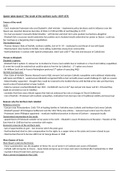Summary
Summary Tudors Depth Study Edexcel History - Revolt of the Northern Earls
- Course
- Institution
- Book
These condensed revision notes provide all the key points you need to know about the revolt of the northern earls during the Tudors. They follow all the key points required by the specification and are useful to look at the night before an exam.
[Show more]




